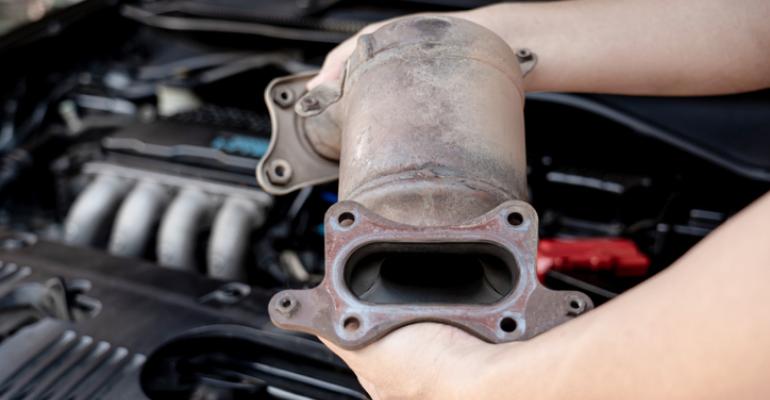Surging catalytic converter thefts have led to the creation of a new finance and insurance product sold at car dealerships.
Automotive veteran Brian Murphy put together the two-part protection plan.
“I was trying to come up with something different and saw what was going on with catalytic converter thefts,” the president of San Diego-based Auto Prime Financial Services tells Wards.
He went on to create SAFECAT, an F&I product that consists of marking converters with vehicle identification numbers and reimbursing consumers who replace the stolen exhaust-system devices.
Catalytic converters reduce tailpipe carbon emissions. To do so, they rely on the rare-earth metals platinum, palladium and rhodium. Those precious metals are what thieves are after when they rip off catalytic converters, literally and figuratively.
The National Insurance Crime Bureau estimates the theft rate of the exhaust system devices increased 326% in 2020 and another 353% in 2021.
Stolen catalytic converters can get anywhere from $20 to $350 on the black market. Replacement costs can run as high as $2,500.
 “It’s a lot of money, and currently there is not a lot of punishment risk,” Murphy (pictured, left) says.
“It’s a lot of money, and currently there is not a lot of punishment risk,” Murphy (pictured, left) says.
The increasing theft rate corresponds with rising prices for platinum, palladium and rhodium. It may not have the name recognition of gold, but rhodium is more expensive.
Palladium prices have skyrocketed, in part because of the Ukraine war. Russia supplies 40% of that metal. “The war disrupted the supply and price,” Murphy says of palladium. An ounce of it can supply 15 catalytic converters.
Since 1975, the U.S. federal government has mandated catalytic converters for all gasoline- and diesel-powered vehicles. The converters ultimately will become obsolete when the electric-vehicle age fully kicks in.
But right now, the converters are a hot item among thieves, who range from organized rings to drug addicts trying to make a quick buck for a fix.
“It’s faster and easier to steal a catalytic converter than to steal a car,” Murphy says. “It takes about a minute to cut two pipes and remove the converter. Some vehicles have more than one. The Toyota Tundra pickup truck has four.”
The thefts can occur on city streets, in residential driveways and on car dealership lots. Most victims don’t realize their car has been tampered with – until they start the engine.
Thieves especially target SUVs and pickup trucks because of their high clearances, making it easier for someone to slip under a vehicle.
But low-clearance vehicles are targets too. Some theft teams carry jacks, like the ones racing pit crews use, to quickly lift a car.
“Catalytic converter theft is a major concern for dealers nationwide,” says Mike Stanton, president and CEO of the National Automobile Dealers Assn.
Stolen converters are hard to trace. Murphy says SAFECAT makes them more identifiable.
SAFECAT offers a heat-resistant label with an etching of a car’s vehicle identification number (VIN). The label and laser-cut etching go on a converter.
The VIN is registered in a national data base.
If a stolen catalytic converter is already gutted of its rare-earth materials, the VIN stamp doesn’t help much. But if police find complete catalytic converters at, say, a chop shop, the labeling can identify them as stolen. The VINs can trace them to original owners.
“Without any markings, the police can’t prove a crime took place,” Murphy says.
Separate from the labeling, his company offers to vehicle owners a $3,000 to $6,000 warranty for replacing stolen catalytic converters. Car owners are eligible for that protection. Dealers aren’t, “although many of them have said they’d like to have it.”
Several dealers on the West Coast and in the Midwest have SAFECAT VIN labels on the catalytic converters of vehicles on their lots, he says.
NADA and 12 industry partners have urged the passage of a bill pending in Congress, which is the first to address the problem.
The bill would require that new vehicles have unique identifying numbers stamped on their catalytic converters. It also would make the theft, sale, trafficking or known purchase of stolen catalytic converter a federal crime.
“I cannot overstate the gravity of catalytic converter theft across the country,” says Scott Lambert, president of the Minnesota Automobile Dealers Assn. “Vehicle owners, including dealers and fleet owners, are collectively losing millions of dollars from these thefts, and in light of the global supply chain shortage, it is difficult and extremely costly to replace catalytic converters.”
Based on claims, State Farm Insurance in 2021 ranked the top 10 states for catalytic converter thefts. They are California, Texas, Minnesota, Washington, Illinois, Oregon, Colorado, Ohio, Arizona and Missouri.





